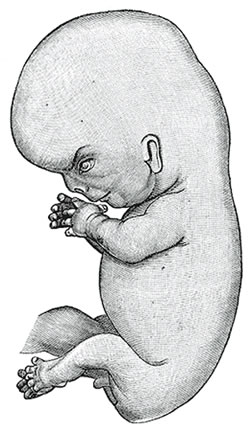Lateral view - Human embryo about
eight and a half weeks old
(UPDATED) The term [ventral] arises from the Latin word [venter] and the root term [ventr-] meaning "belly" or "sac". The adjective [ventral] means "towards the front" , or "towards the belly side of the body". The term ventral therefore means "abdomen".
Many use the term [ventral] synonymously with "anterior"; although this is technically correct, the proper term to use when referring to the patient in the anatomical position should be "anterior". In embryology, since the embryo is curved, most of the anterior aspect of the embryo looks towards the abdomen, ergo ventral.
A ventral hernia is any herniation that occurs in the anterior aspect of the abdomen, including Spigelian hernias, omphaloceles, etc.
Other terms that arise from the same root term are [ventricle], meaning "little belly", or "little sac", and [ventricular], meaning "pertaining to a ventricle".
Note: A comment from my friend Dr. Elizabeth Murray:
"My understanding of "anterior" means "in the direction of movement" for any given organism (and "posterior" means opposite the direction of movement for an organism). Thus, ventral does not ever change for any creature (vertebrate or even invertebrate), as it refers to a body part/surface. But when considering two-legged and four-legged (or finned) creatures, you see the differences: Ventral = anterior in us, but in a dog or fish ventral = inferior.
Ventral/dorsal refer to belly/back in any organism, and cranial/caudal refer to head-end and tail-end in any organism -- those four terms refer to body parts. However, anterior/posterior refer to the way an organism moves in space, and superior/inferior refer to an organism's relationship to the earth/pull of gravity."
An interesting side note: The word [ventriloquist] arises from the root term [-ventri-] from the Latin [venter] and the suffix [-loquist], from the Latin [loquos] and [locutus], meaning "to speak", or "someone who speaks". The term [ventriloquist] means then "someone who speaks from the abdomen (or stomach)". We now know that this is not so, but that is what most people think a ventriloquist does!
Sources:
1 "Tratado de Anatomia Humana" Testut et Latarjet 8 Ed. 1931 Salvat Editores, Spain
2. "Anatomy of the Human Body" Henry Gray 1918. Philadelphia: Lea & Febiger
Image modified by CAA, Inc. Original image by Henry Vandyke Carter, MD., courtesy of bartleby.com



